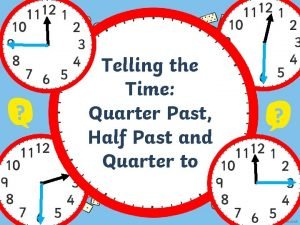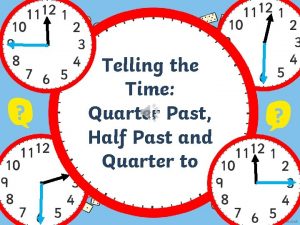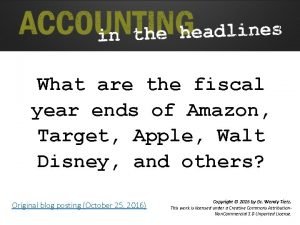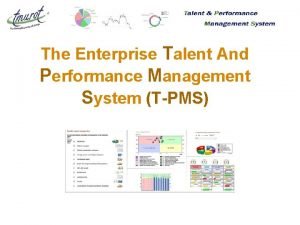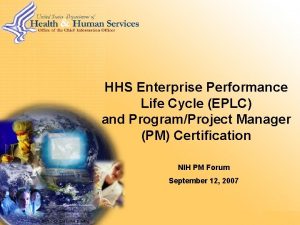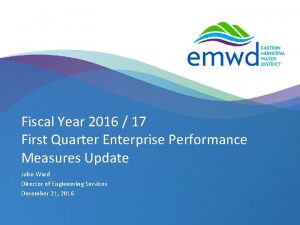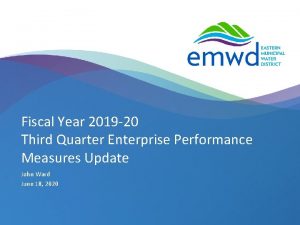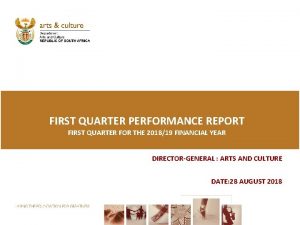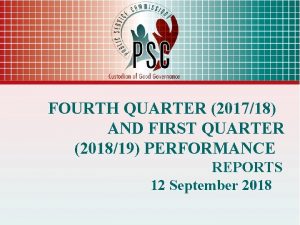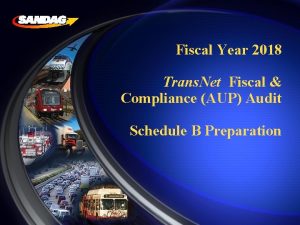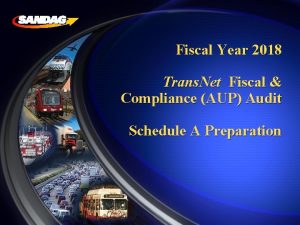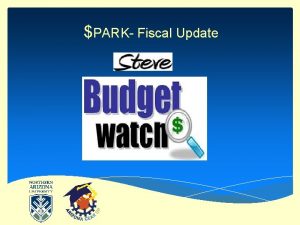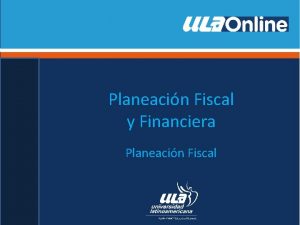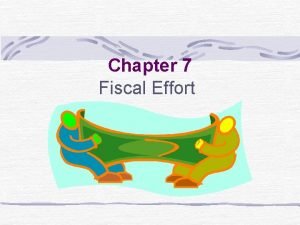Fiscal Year 2018 19 First Quarter Enterprise Performance
















- Slides: 16

Fiscal Year 2018/ 19 First Quarter Enterprise Performance Measures Update John Ward November 15, 2018 | emwd. org

Fiscal Year 2018 -19 First Quarter Enterprise Performance Measure Enterprise Measures provide a summary of the District’s performance in a single graphic report. Twelve proposed measures organized by the following categories: • Efficiency • Reliability • Service • Safety • Financial Performance Goal: Provide the Board of Directors critical and timely business and financial information and identify trends. 2 | emwd. org

Efficiency - Water Operating Cost per AF Delivered Graph Chart 3 | emwd. org Metric: Monthly water operating cost per acre foot (AF) delivered per month during the previous six months. Specifically, it measures the operating cost for water, including purchased water cost, O&M, energy, support costs, and administration relative to total acre feet sold. Importance: This metric serves as an indicator of operational efficiency related to the purchase, treatment, pressurization, and distribution of potable water. Goal: The fiscal year goal is $1, 542 / AF, which is the average water service operating cost per acre foot from the fiscal year 2018/19 budget ($121. 5 million operating cost for 78, 800 acre feet in sales). This goal has been averaged out by month taking into account historical data to reflect seasonal changes in water usage. Results: The price per acre foot for Q 1 is favorable. July trended above average due to lower than projected water sales and higher purchased water costs as a result of deliveries to WMWD from EM 17.

Efficiency - Wastewater Treatment Operating Cost per MG Treated Metric: Monthly wastewater operating cost per million gallons (MG) treated per month during the previous six months. The costs include treatment, collections, recycled disposal, energy, sludge hauling, support costs, and administration. Importance: This metric is an indicator of wastewater system efficiency. Goal: The fiscal year goal is $3, 949 / MG, which is the average wastewater service operating cost per million gallons from the fiscal year 2018/19 budget ($62 million operating cost for 43 MG over 365 days). Results: Q 1 results were favorable. Graph Chart 6 | emwd. org

Efficiency – Recycled Water Operating Cost per AF Delivered Metric: Monthly recycled water operating cost per acre foot (AF) per month during the previous six months. Specifically, it measures the total operating cost for recycled water, including transmission, pumping, energy, storage, and support costs relative to total acre feet sold. Importance: This metric provides the District with a long term indication of recycled water system efficiency. Goal: The fiscal year goal is $186 / AF, which is the average recycled water operating cost per acre foot from the fiscal year 2018/19 budget ($6. 7 million operating cost for 36, 000 acre feet in sales). Results: Q 1 results were favorable with September trending above average due higher labor costs. Graph Chart 9 | emwd. org

Efficiency – Self-Generated Power Metric: Percent of EMWD self-generated power from solar panels, fuel cells, micro turbines and fuel cells compared to total potential production. Importance: This metric tracks the District’s efforts to reduce dependency on purchased energy. Goal: The monthly goal is to utilize all selfgeneration potential ability at 90 percent or more. Results: The trend for Q 1 is slightly below the trend line due to data capture issues with the fuel cell units, chiller failure caused the microturbines to shut down, and the month of July solar underperformed. 12 | emwd. org

Reliability– Customer Hours Out-of-Service Metric: Sum of the hours out of water multiplied by the number of water accounts affected per event divided by 1000. For example, if 100 customer accounts are out of water for ten hours, the measure would reflect one Out-of-Service hour per 1000 accounts for that event. Importance: This metric measures the District’s performance related to restoring water service to our customers. Goal: The fiscal year goal of six hours per 1000 accounts has been established based on 12 months of performance. Results: The trend was above the target for Q 1 with the largest outage in August related to a planned new valve installation and piping modifications near Briggs Rd and Mc. Laughlin Rd in Menifee. There was also a leak in Sun City on Bradley and El Rancho. 13 | emwd. org

Reliability – Wastewater Treatment Reliability Metric: This metric is intended to measure the District’s performance related to Wastewater Treatment Facility Production Uptime. It represents the average uptime of various treatment processes. Importance: RWRF production affects the Recycled Water Supply. Goal: A goal of 98 percent uptime has been established based on twelve months of data. Results: The trend was favorable for Q 1. Chart 14 | emwd. org

Reliability – Wastewater Spills of Collection and RWRF Systems Metric: Measures the number of spills in the Wastewater collection and treatment facilities. Within the treatment facilities, a spill is defined as raw or secondary sewage spills greater than 1, 000 gallons, tertiary greater than 50, 000 gallons, or any effluent that left the plant property. Importance: This metric measures the District’s compliance with regulatory requirements. Goal: The fiscal year goal of less than three spills per month has been established based on 24 months of data and industry benchmarks. Results: Two reportable spills occurred in the quarter. Recycled leak at the PVRWRF and a sewer spill due to sticks in the pipeline on Chagall Court in Moreno Valley 16 | emwd. org

Service – Customer Satisfaction Score of Last Experience Survey Metric: Measures the weighted average score of the Last Experience Surveys received. The surveys include customer service call-ins as well as customers who have recently contacted the District regarding a system concern. Importance: This metric provides staff with a leading indicator of customer satisfaction related to recent customer contact. Goal: The fiscal year goal is to receive 90 percent Satisfaction of all survey responses. Results: The tracking system was down for the month of November - April. Staff is reviewing the data collection process to increase the sample size. September trended below the goal due a high wait time for Spanish speaking calls. The calls with the lowest scores were received during lunch time or on a Friday where staffing is decreased. 17 | emwd. org

Safety – Injury and Illness Rate Metric: Measures the District’s Injury and Illness Rate as defined by OSHA (Annual Sum of recordable injury / illness multiplied by 200, 000 and divided into the Annual Sum of Hours worked by all employees). The District score is presented as a rolling 12 -month average. Importance: This metric measures the effectiveness of the District’s Total Safety Culture. Goal: The fiscal year goal of 4. 25 has been established based on six months of data. Results: The trend for the past two quarters is favorable. Graph 18 | emwd. org

Financial – General and Admin. Costs as a Percent of Total Operating Cost Metric: Monthly non-allocated general and administrative (G&A) costs as percent of total operating costs (including the G&A costs) during the previous six months. The District score is presented as a rolling 12 -month average. Importance: This metric measures the nonallocated G&A costs to support the general administrative facilities and operations of the District. Goal: The fiscal year goal is 11. 6 percent, which is the level from the fiscal year 2018/19 budget ($26. 7 million non-allocated G&A relative to $230, million cost; $26. 7/$230 = 11. 6 percent). Results: Results are favorable for the last quarter. Chart 20 | emwd. org

Financial Performance – Net Operating Margin (Revenue Minus Cost) Metric: Monthly operating revenue (water, wastewater, and recycled) less operating costs during the previous six months. Importance: This metric measures the net operating margin of the District’s services. If margins are insufficient, net contributions to District reserves are impacted. Goal: The fiscal year goal is $1. 95 million per month, which is from the fiscal year 2018/19 budget ($240. 2 million in operating revenue less $190. 2 million in operating cost less $26. 7 million of unallocated G&A expense = $23. 4 million annual operating margin). Results: Results remain favorable over the last two quarters due to higher seasonal water sales. Graph 22 | emwd. org

Financial – Investment Performance Compared to 3 Year Treasury Yield Metric: Annualized investment yield of District’s portfolio compared to the three-year US Treasury yield. Importance: This metric measures the investment performance of the funds managed by the District. Goal: The fiscal year goal is to exceed the threeyear US Treasury yield benchmark each month, which varies. Results: District investment performance continues to trend slightly below goal through Q 1. Investment objectives remain focused on safety and liquidity. Graph 24 | emwd. org

Summary For the first quarter of FY 2018 -19, ten out of twelve measures are performing better than the monthly goal. Two measures are not meeting the respective goals: • Self Generated Power • Customer Hours Out of Service Next quarterly report is scheduled for February of 2019. 26 | emwd. org

Contact Information John Ward Director of Engineering Services (951) 928 -3777 Ext. 4453 Email: wardj@emwd. org 27 | emwd. org
 Quarter half an hour
Quarter half an hour Quarter past 7
Quarter past 7 When is amazon's fiscal year end
When is amazon's fiscal year end Dada la siguiente secuencia rusia 2018 rusia 2018
Dada la siguiente secuencia rusia 2018 rusia 2018 Which best explains why the moon has phases
Which best explains why the moon has phases First quarter moon gif
First quarter moon gif Putting the enterprise into the enterprise system
Putting the enterprise into the enterprise system Putting the enterprise into the enterprise system
Putting the enterprise into the enterprise system Leavers assembly poem
Leavers assembly poem Enterprise performance management
Enterprise performance management Eplc project management methodology
Eplc project management methodology Ibm's first 64 bit enterprise operating system
Ibm's first 64 bit enterprise operating system First year seminar
First year seminar Intellectual development of infants chapter 9
Intellectual development of infants chapter 9 Hebrew month of abib
Hebrew month of abib Mun policy statement example
Mun policy statement example What is kinesiology
What is kinesiology
